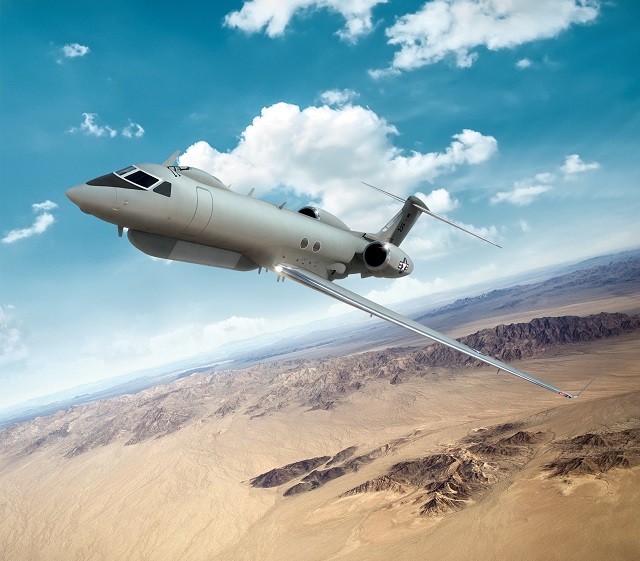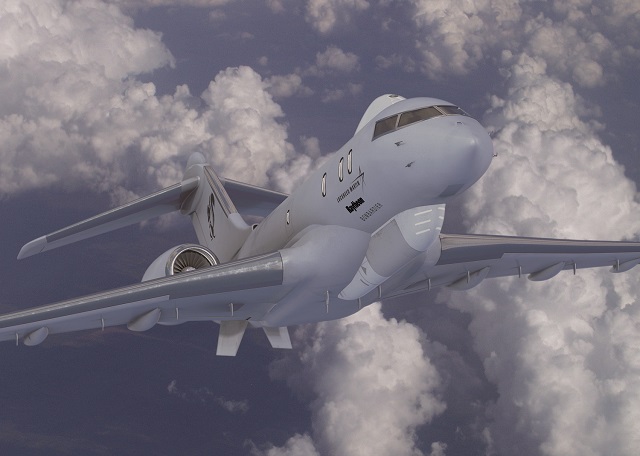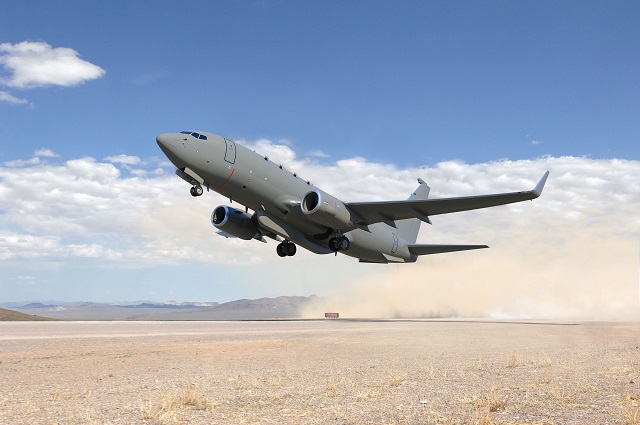The US Air Force’s $6 billion programme to replace the Boeing 707-based Northrop Grumman E-8C “JSTARS” is shaping up as a battle between platform providers rather than the primes, with Boeing, Bombardier and Gulfstream locked in a three-way contest for the 17-aircraft order.
The prime motivation for radar-carrying aircraft competition is to drastically cut the operating and maintenance cost of the E-8C Joint Surveillance Target Attack Radar System (JSTARS) by migrating to a modern “business jet” – specifically an aircraft with 80% less fuel consumption than the 707-300 and a 12-person crew, down from 21.
The E-8 made its combat debut in Operation Desert Storm in 1991 and has provided critical capability in every major US combat operation since – using its 7.3m (24ft) side-looking phased array radar to detect enemy ground and maritime movements and low-flying aircraft over a 50,000km2 area. Its onboard battle management specialists harness that information to alert friendly ground forces and coordinate counterattacks or air strikes.
But the air force says the E-8C’s extraordinarily high operating cost is eating its budget, and a new platform that requires less fuel, maintenance and personnel would deliver savings on day one.
It is true that the replacement’s advanced radar, communications and battle management systems are central to the next-generation JSTARS design, but the next platform will be the discriminator in terms of mission performance, readiness and reliability, basing, support and total life-cycle cost.
When it comes down to raw performance, the platform’s speed, range, altitude, power and payload will dictate how much JSTARS “capability” can be crammed into the new weapon system.
The three prime contractors in the race are Boeing (offering its commercial 737-700BBJ), Lockheed Martin (Bombardier Global 5000 or 6000) and Northrop (Gulfstream 550 or 650).
Each team recently received $10 million for an 11-month risk reduction phase ahead of a competitive downselect for the development contract in 2017. The current air force schedule places initial operational capability in 2024 and full capability with 17 mission aircraft in 2027.
The platforms under consideration all have inherent strengths and weaknesses – although the larger Boeing Business Jet (BBJ) is an outlier in terms of cabin size, considered a “business liner” by some.

Northrop Grumman, L-3 Aerospace Systems and Gulfstream Aerospace have teamed for JSTARS and will offer the 550 or 650 business jets.
Gulfstream
For General Dynamics Gulfstream, the chance to add another special mission derivative aircraft to its portfolio of government contracts has a certain allure, but there is also the up-front profit from a 17-aircraft sale and the long-term income from after-sale services and support.
On 2 September, the company flew Flightglobal and a dozen or so reporters to its headquarters in Savannah, Georgia, where it produces about 130 aircraft per year (the 450, 550, and 650 types). The travel was via a company-owned 450 and 550 departing from Dulles International Airport.
Gulfstream executives say the choice of platform will be one of the deciding factors in this competition, and it makes much more financial sense to transition to a modern business jet than to keep upgrading old, second-hand 707s built in the 1960s and ‘70s.
“The platform really impacts mission performance. [It] informs all the other mission systems,” says Troy Miller, Gulfstream’s regional vice president of military and special mission sales.
“A platform with the mature, proven capability of the G550 and the special mission capabilities of Gulfstream really lends itself to an important air force priority and an important priority of Northrop Grumman – that’s speed to ramp . . . and reduced life-cycle cost of the weapon system.”

Northrop's own Gulfstream GV JSTARS testbed aircraft was on display for the media 2 September at Gulfstream's headquarters in Savannah, Georgia.
Northrop Grumman
Northrop sees the 550 as the ideal balance between cost and performance going into the JSTARS competition, although it could offer the newer, longer-range 650 if requirements change.
The 550 has a range of 6,750nm at Mach 0.8, compared to the 650 which has a 7,000nm range at Mach 0.85. That’s the equivalent of a non-stop hop from Washington to Tokyo for the G550, or Los Angeles to Melbourne, Australia for the 650.
There is also an air-to-air refuelling requirement, giving the next-generation JSTARS perhaps more endurance than required for an average mission, but enough to fly non-stop to anywhere in the world.
Miller says air refuelling has never been done on a Gulfstream business jet, but he considers it less of an engineering challenge for the 550 or 650 than for an airliner since the fuel is stored entirely in the wings.
“We have looked at probe and drogue and boom refuelling,” he says. “The air force clearly has certain demands, despite the G550 meeting the refuelling requirement.”
Perhaps more importantly for the JSTARS mission is the Gulfstream offering’s short takeoff distances, speed and cruise altitude of 41,000ft to 51,000ft.
These flight characteristics are comparable to the Bombardier Global 5000 and 6000, and the Embraer E-Jet E2 alternatives that have been assessed by the competitors, namely the 190 and 195.
Northrop team officials note that flying higher makes you more difficult to shoot down, but it also allows the radar to cover a wider area without obstruction from mountains.
The 550’s high-set Rolls-Royce BR710 engines (BR725s for the 650) and smooth underbelly also limits obstruction to the radar, which would be mounted under the forward fuselage.
The engines generate general 45kVA each, and with the addition of two 45kVA auxiliary power units, the aircraft has ample power to meet the needs or the radar, communications and computer systems.
The power units and radar would be liquid cooled on the Gulfstream jet, with a special radiator mounted at the rear.

Lockheed Martin will offer a Bombardier Global-series platform.
Lockheed Martin
There are currently 70 Gulfstream aircraft in service with the US government including 23 designated as C-37s for government executive airlift, with the US Air Force being the largest operator.
Around the world, the Gulfstream jets are used for intelligence, surveillance and reconnaissance (Israel), atmospheric research (one stationed in Germany and one in the USA), airborne early warning (Israel and Singapore), maritime patrol (Japan), and medical evacuation (Saudi Arabia).
For flying in wartime conditions and poor weather, Gulfstream executives point to the company’s enhanced vision system, head-up display and large aircraft infrared countermeasure offerings.
The company says the direct operating cost of a Boeing Business Jet is 46% greater than a 550 or 650, but perhaps where the Gulfstream offering falls short is cabin space.

An artist's concept of Boeing's 737-300BBJ1-based offering for JSTARS.
Boeing
Boeing contends that the BBJ can carry far more equipment and is far roomier than a G550, which means more room for growth and greater crew comfort.
How that factors into the final source selection decision is unclear, but both Gulfstream and Bombardier will struggle to compete with the crew space and payload provided by the BBJ.
Northrop is confident its JSTARS system requires no more than 10 mission specialists working at 10 computer stations, and with the two pilots and third back-up pilot, there is enough room on the 550.
Northrop vice president and JSTARS programme lead Alan Metzger says the 550 is the right match, and meets or exceeds all of the draft requirements produced by the air force to date.
If successful, Gulfstream says it would need 12 to 18 months lead time to deliver the first aircraft. The next available spot in the production line is 2017, it says.
The 450 and 550 are assembled on the same line, and would be delivered without modification to Northrop and the third team member, L-3 Aerospace Systems, for conversion into a JSTARS.
Source: FlightGlobal.com
















